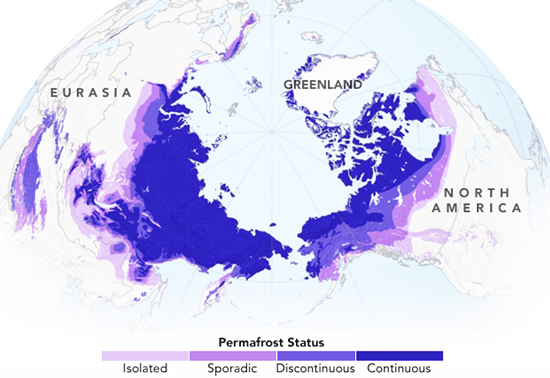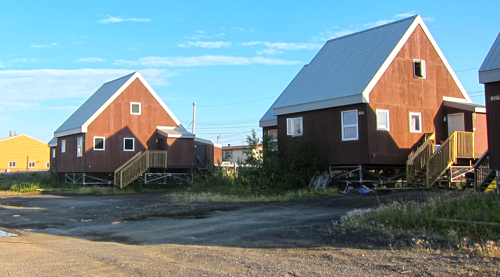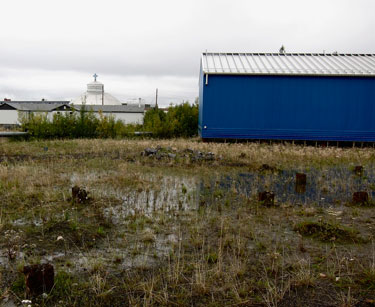Walk the streets of Inuvik, an Arctic town of about 3,000 people in northwestern Canada, and you’ll notice that all the buildings hover above the ground. They rest on wooden stacks, metal scaffolding, or some variation of wood or steel pillars similar to those found beneath docks.
Residents of this town, situated about 100 kilometers south of the Arctic Ocean, raise their buildings to anchor against the ever-shifting permafrost (permanently frozen ground) that heaves and thaws beneath them each year. Some supports or pilings work better than others, evidenced by abandoned lots where houses or other buildings once were.
“We are trying to figure out what types of foundational design would increase the longevity of these buildings in light of climate change.”
Now, as climate change rapidly thaws permafrost, structures here and across the Arctic are increasingly slumping into the ground. Researchers at Inuvik’s Aurora Research Institute (ARI) are joining in a wave of new civil engineering efforts to address these structural challenges by testing out a new type of piling. They hope that their experiments will inform infrastructure innovation across the Arctic.
“We are really in a time when we are trying to figure out what types of foundational design would increase the longevity of these buildings in light of climate change,” said Erika Hille, manager of ARI.
Inuvik lies within the fastest warming region of the Arctic, so the need to stabilize buildings here is urgent, she said.

The Heat Is On
Winter temperatures in Alaska and western Canada have risen an alarming 3°C to 4°C over the past 50 years, according to a report from the Arctic Monitoring and Assessment Programme (AMAP). Quickly melting sea ice in this region may be a leading cause of this unprecedented change, said Hille: The exposed ocean has decreased albedo, or surface reflectance of the Sun, compared with sea ice. This darker surface warms water locally and amplifies melting and warming across the region in a feedback loop.
Climate models predict that nearly a quarter of permafrost in Canada will thaw down 3 meters by 2100, the AMAP report also states. As the ground softens, the land will become soggy, and foundations will sink with it, Hille said.
Experimental Construction
When ARI broke ground in 2011 on a new building, in part to replace old pilings, the late Canadian permafrost scientist Ross Mackay saw a research opportunity in the construction project: He proposed that ARI install three experimental pilings among the roughly 90 other traditional steel pilings that were planned to support the two-story building.

The traditional steel pilings measure roughly half a meter in diameter, are filled with a gravel slurry containing a mixture of sand and mud, and reach about 14 meters down—far below the site’s 4-meter-deep active layer, the layer of soil that thaws each spring. The experimental pilings are exactly the same, except they are left hollow and have vents at the top. Mackay and others involved in the experiments wondered if a hollow pillar would stay cold longer than a filled pillar because it would collect and retain cold air through convection.
“The idea was that during winter, the cold air would force any warm air out of the pile and that the temperature within the pile would become colder than if it were backfilled,” said Hille.
Next to these pilings, ARI installed ground temperature monitors at half-meter increments to collect readings twice daily. This installation was done to test the effectiveness of the new design and also to accrue valuable long-term data on ground temperature changes.

False Starts
With 6 years of data collected so far, the experimental pilings aren’t working as expected: Convection does cool the pilings in the winter, but springtime ground temperatures have risen higher around the experimental pillars than the traditional ones. ARI researchers attribute this to premature warming of the air within the hollow pilings because of heat exchange through the steel casings of the pillars. The infiltrating springtime warmth more easily raises the temperature of an inner column of air than of frozen slurry, an effect the team hadn’t foreseen.
Even so, the experiment and accompanying daily ground temperature data have provided useful information to researchers investigating best practices in piling design.
“I think it’s great,” said Yuxiang Chen, an environmental engineer at the University of Alberta in Edmonton who plans to eventually use ARI’s ground temperature data in models to determine the ideal depth to place pilings. “It’s an urgent matter, looking at how to tackle this problem.”
The Future of Pilings

In Inuvik, steel pilings filled with gravel slurry are steadily replacing the original pillars of wood used in buildings constructed in the 1950s, said Merle Carpenter, regional superintendent for the Department of Infrastructure of the government of the Northwest Territories. The jury is still out on the long-term value of hollow pilings, although they don’t look like a viable option at the moment, he said. However, an even newer iteration, a steel piling shaped like a screw, shows greater promise, he noted. Screwing a piling into the ground displaces and disturbs less permafrost than the drilling required to install current pilings.
It’s hard to know what will work best in the long term because nobody in the Arctic has ever experienced the rate of exponential permafrost change occurring today.
However, said Hille, it’s hard to know what will work best in the long term because nobody in the Arctic has ever experienced the rate of exponential permafrost change occurring today. They won’t know whether hollow pilings are a viable alternative until they have about 15 years of data, she said, so they will continue collecting temperature data twice each day. Doing so also adds value to the project because it is one of only a handful of long-term ground temperature monitors in Canada.
“We’re just trying to figure out the best way to mitigate this change,” she said.
—Laura Poppick (email: [email protected]), Freelance Science Journalist
Citation:
Poppick, L. (2017), Engineering new foundations for a thawing Arctic, Eos, 98, https://doi.org/10.1029/2017EO080435. Published on 22 August 2017.
Text © 2017. The authors. CC BY-NC-ND 3.0
Except where otherwise noted, images are subject to copyright. Any reuse without express permission from the copyright owner is prohibited.

